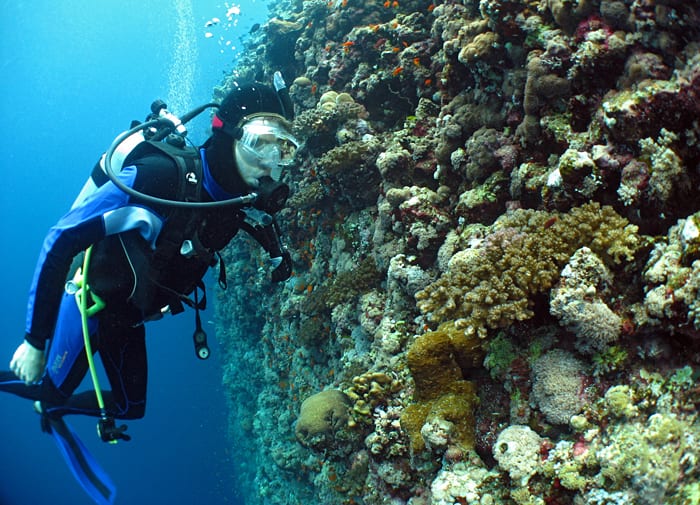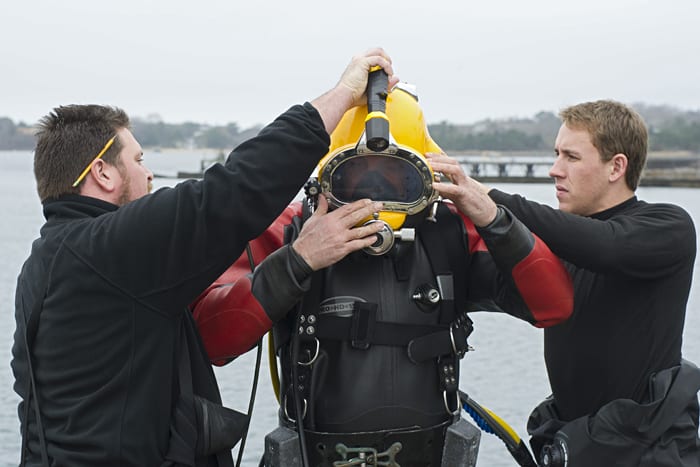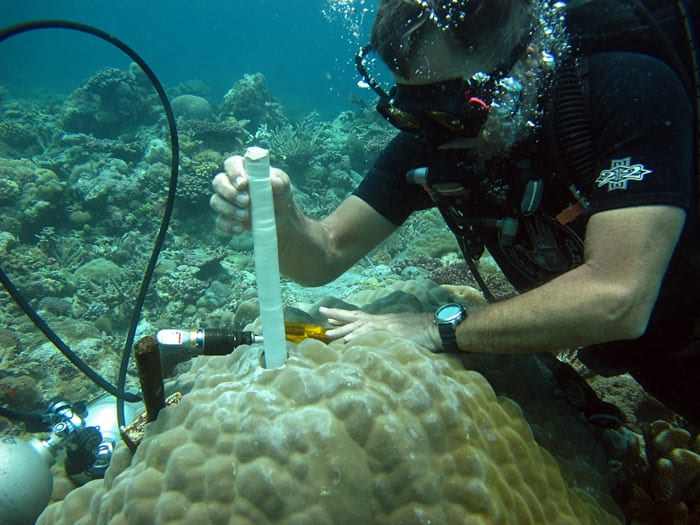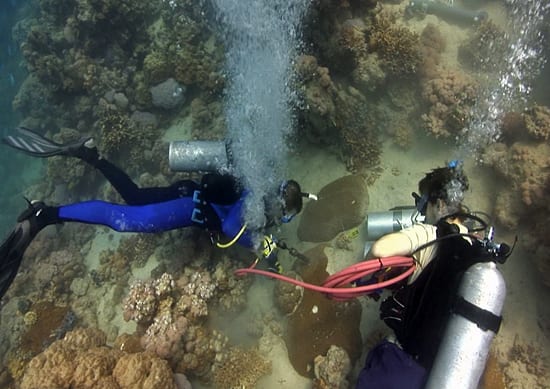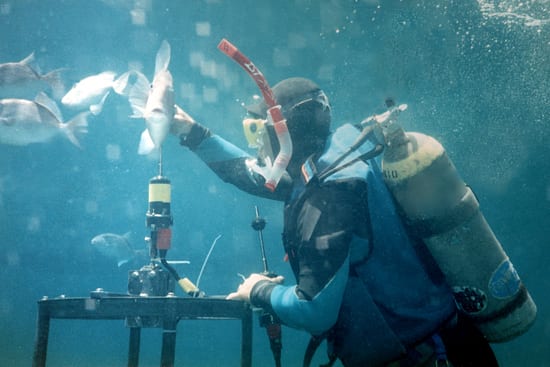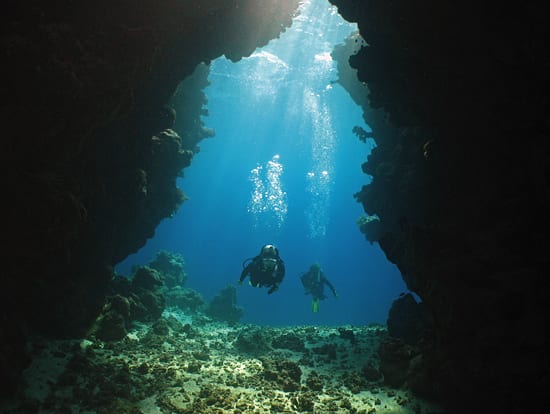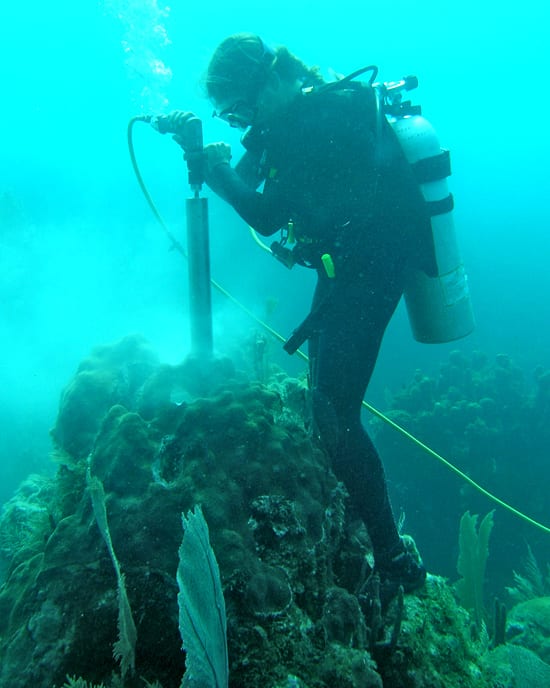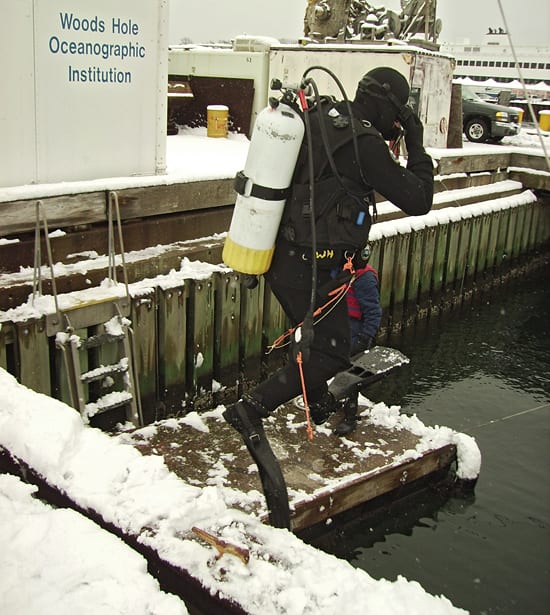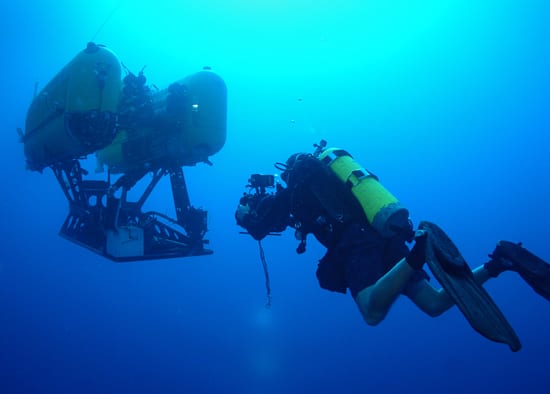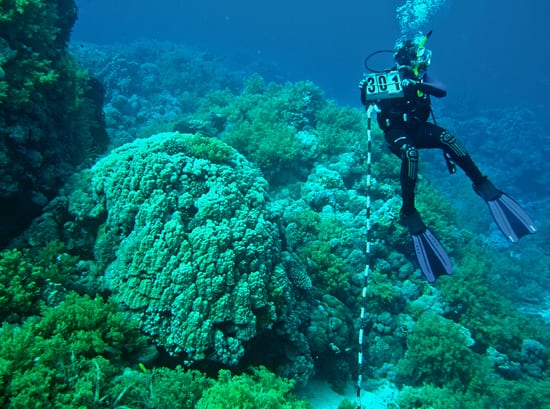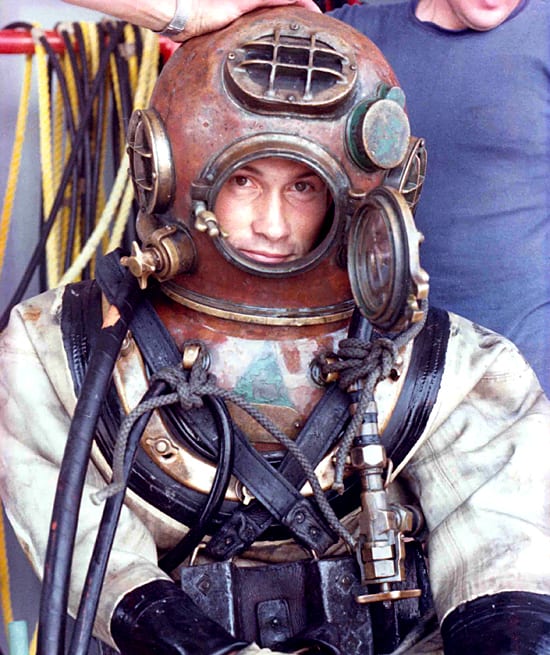WHOI Diving in Photos
Kelton McMahon, a postdoctoral investigator in WHOI's Fish Ecology Laboratory and a graduate of the MIT/WHOI Joint Program in Oceanography, observes the fish living on a coral reef. McMahon has been studying the ecological links between reefs, where adult fish spend most of their time, and coastal mangrove swamps, the "nurseries" where they lay their eggs and where the juvenile fish grow up. Scientists like McMahon frequently don SCUBA gear to enter the watery world of the fish they study. (Photo courtesy of Simon Thorrold, Woods Hole Oceanographic Institution)
Assistant marine ops coordinator Chad Smith and Julian Schanze, a graduate student in the MIT/WHOI Joint Program, help Dive Officer Ed O'Brien into his hardhat diving gear. The three divers were preparing to inspect and clean the propeller on R/V Oceanus at the WHOI dock. O’Brien supervises the WHOI Diving Program, which trains researchers how to dive safely so they can collect specimens, maintain equipment, and directly observe behavior of organisms in the sea. Diving is often the best way to accomplish an oceanographer's goals, even in frigid water or the open ocean far from a coastline. (Photo by Tom Kleindinst, Woods Hole Oceanographic Institution)
WHOI scientist Pat Lohmann removes a core drilled from a living coral during a recent field expedition to Palau, a remote coral reef archipelago in the far western Pacific. The core can be thought of as a biopsy that reveals how the coral is reacting to climate changes, in particular, ocean warming and acidification. Palau is a coral reef system currently studied by Anne Cohen's lab. (Photo by Anne Cohen, Woods Hole Oceanographic Institution)
WHOI post-doctoral researcher Neal Cantin (left) and MIT/WHOI Joint Program student Casey Saenger (right) collect tissue samples from a Diploastrea coral near a Red Sea cement plant. Cantin and other WHOI researchers are exploring the anthropogenic impacts on the reef in the region. The coral's tissue is expected to re-grow over the sampled region in the next year. (Photo by Pat Lohmann, Woods Hole Oceanographic Institution)
A diver services instruments collecting data in the surf zone. Currents, waves and sands constantly change the shoreline. (Photo by Britt Raubenheimer, Woods Hole Oceanographic Institution)
MIT/WHOI Joint Program graduate student Kelton McMahon (front) and WHOI research assistant Leah Houghton enter a large underwater cavern on a Red Sea coral reef off Alith, Saudi Arabia in search of adult snapper fish. By analyzing fish otoliths, or ear bones, McMahon can discern where fish spent their formative juvenile years and help identify critical areas that should be protected to prevent the demise of coral reef fish populations. (Photo by Michael Berumen, Woods Hole Oceanographic Institution)
A diver collects a sample from a coral in Honduras for climate studies. The coring does not harm the colony, which continues to grow. (Photo by Konrad Hughen, Woods Hole Oceanographic Institution)
Not all scuba diving occurs in balmy seas or near coral reefs. Scientists dive in Antarctica to collect zooplankton that occur nowhere else, and—as shown here—divers brave the icy waters near Woods Hole to install and maintain ocean-monitoring instruments. (Photo by Terry Rioux, Woods Hole Oceanographic Institution)
A diver films the deep-sea explorer Nereus from the water during its second expedition in 2009 to investigate hydrothermal vents along Earth’s deepest mid-ocean ridge in the Cayman Trough. On May 31, 2009, the robotic vehicle successfully reached the deepest part of the world’s ocean — the Challenger Deep in the Mariana Trench in the western Pacific Ocean. (Photo courtesy of Advanced Imaging and Visualization Laboratory, Woods Hole Oceanographic Institution)
- Through a research agreement with King Abdullah University of Science and Technology, WHOI scientists are studying coral reef ecosystems, fisheries, and water circulation along Saudi Arabia’s Red Sea coast. The first priority is to assess the health of extensive coral reefs and identify environmental factors affecting them. This work involves commercial dive boats, local dive-tour operators, and coral measurements by WHOI scientists, including MIT/WHOI Joint Program student Jessie Kneeland, shown here. These studies will provide a baseline for monitoring this vital and still-unspoiled ecosystem in a time of ongoing coastal development and climate change. (Photo by Konrad Hughen, Woods Hole Oceanographic Institution)
- WHOI diving safety officer Terry Rioux dons a "Mark V" diving helmet at the Mobile Diving and Salvage Unit Two, in Little Creek, Va, in June 1978. Before and during his tenure at WHOI, Rioux was a diver for the U.S. Navy and Navy Reserves. According to Rioux, the Mark V helmet —which allowed breathing gases to be pumped down from a surface ship through an umbilical to the diver—was used for heavy salvage work from before World War I up until it was replaced by a more modern system in the 1980s. (Photo courtesy of Woods Hole Oceanographic Institution Archives)
Image and Visual Licensing
WHOI copyright digital assets (stills and video) contained on this website can be licensed for non-commercial use upon request and approval. Please contact WHOI Digital Assets at images@whoi.edu or (508) 289-2647.

